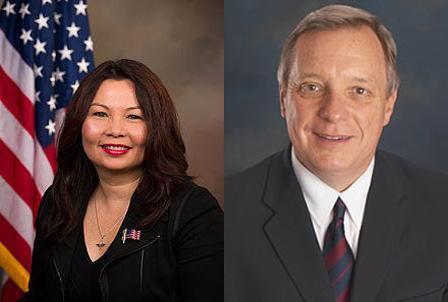
WASHINGTON – Following last week’s string of severe weather and tornadoes that caused extensive damage and three fatalities across Illinois, U.S. Senators Dick Durbin (D-IL) and Tammy Duckworth (D-IL) today announced the introduction of the Fairness in Federal Disaster Declarations Act. The bill would reform the Federal Emergency Management Agency's (FEMA) disaster declaration process to make it more transparent and equitable to small and rural communities in larger states like Illinois. Due to FEMA’s disaster declaration process, it does not appear that Illinois will qualify for federal aid to repair the expansive damage that the storms caused last week. Durbin first introduced the bill in 2012 after FEMA denied federal assistance to Harrisburg, Illinois and Ridgway, Illinois following a devastating outbreak of storms and tornadoes.
Get The Latest News!
Don't miss our top stories and need-to-know news everyday in your inbox.
“Changes to FEMA’s disaster declaration process can’t come soon enough for communities across Illinois and I am glad that Senator Duckworth has joined me in support of this legislation,” said Durbin. “Time and time again, we see severe weather strike a community in Illinois, causing tremendous damage, yet we aren’t able to count on the federal government to provide assistance when it does. This is flat out wrong. It’s time to fix the broken metrics that FEMA uses to determine disaster assistance and bring some fairness back into the system so that people in Illinois are not unfairly punished.”
“As Americans, it’s our responsibility to support one another in times of need, especially when our communities are devastated by severe weather,” said Duckworth. “Families in Central and Southern Illinois demonstrated tremendous courage and resilience last week after they faced heavy storms and tornados, but many are still in need of additional assistance. That’s why this legislation is so important – it will help ensure Illinoisans in every corner of the state can receive the resources and support they deserve to rebuild critical infrastructure and repair damages after weather-related disasters.”
According to a report by the Congressional Research Service (CRS), FEMA already takes into account several factors when determining the need for Public and Individual Assistance. However, there is currently no standard to determine which factor is more important than another, which leads to a highly subjective and uncertain process that leaves states and communities in limbo for weeks as their application is considered.
The Fairness in Federal Disaster Declarations Act of 2017 will provide more certainty and fairness to states and small communities impacted by disasters by giving FEMA a clearer, more substantive formula when evaluating disaster areas. This bill assigns a specific weight to each of the factors already used by FEMA, and adds other economic factors for the agency to consider when determining whether or not a disaster area should receive federal assistance.
The formula breakdown for Public Assistance specified in the legislation and a description of each factor currently used by FEMA is below:
- Estimated cost of the assistance (10%) - Currently, this is the key component to FEMA's declaration process, calculated at $1.35 times the state population. This legislation will make it less of a factor by weighing it significantly lower than localized impacts.
- Localized impacts (40%) - The legislation would put greater weight on the damage assessment on a specific area, as opposed to statewide.
- Insurance coverage in force (10%) - Currently, FEMA deducts the amount of insurance that should be held by a government and non-profits from the total eligible amount.
- Hazard mitigation (10%) - If the cost of damage falls short of the cost of assistance threshold due to mitigation measures that lessened the disaster's impact, FEMA will take this into consideration by doing a cost-benefit analysis.
- Recent multiple disasters (10%) - FEMA would take any disasters occurring within the previous 12 months into consideration and evaluate the funds that the state has committed and their impact on the state and its residents.
- Programs of other Federal assistance (10%) - FEMA would take into consideration whether or not other agencies will be contributing.
Other economic circumstances (10%) - Currently these are factors not considered by FEMA. This legislation would require FEMA to consider the local assessable tax base and local sales tax, the median income in comparison to the state, the poverty rate in comparison to the state, and the unemployment rate of the state in comparison to the national rate.
The formula breakdown for Individual Assistance would be:
- Concentration of damages – 20%
- Trauma – 20%
- Special populations – 20%
- Voluntary agency assistance – 10%
- Insurance – 20%
- Average amount of individual assistance by State – 5%
- Economic considerations – 5%
More like this:
